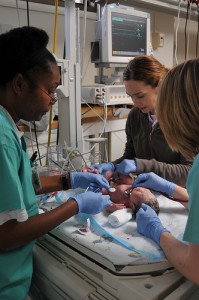
Sepsis, a serious, hard-to-diagnose threat in the NICU, can interfere with a baby's development even when cleared with antibiotics. (Image: Army Medicine/Flickr)
Sepsis, or bacterial infection of the bloodstream, is a grave threat to premature infants in the neonatal intensive care unit (NICU) who have catheters and intravenous lines. Even when antibiotics clear the infection itself, the inflammation that it causes can do just as much damage. Not only can sepsis and the resulting inflammation interfere with fragile preemies’ ability to gain weight, but a growing literature suggests that they can impair brain development.
Preventive measures can now avoid many cases of sepsis, but those that slip through can be hard to detect in newborns.
“Newborns can’t speak, and they have unique immune systems, so they tend not to have fevers or show clinical signs,” explains Ofer Levy, MD, PhD, of the Division of Infectious Diseases at Boston Children’s Hospital. “There may be irregular breathing or increased heart rate, or the baby may be acting a little ‘off,’ but these signs are pretty nonspecific. There’s a tremendous need for better diagnostics in this field.”
Levy and colleagues recently described a mouse model that, for the first time, captures the effects of sepsis on the newborn immune system. They and others have begun using it to identify diagnostic markers and better treatments.
The main hurdle was the technical challenge of working with tiny newborn mice. Kenny Kronforst, MD, MPH, a clinical Newborn Medicine fellow working in Levy’s lab, was dexterous to inject live Staphyloccus epidermidis—the bacterium that causes most cases of sepsis in newborns—into the tiny animals’ jugular veins.
The experiment simulated what happens when an IV or catheter infection occurs in an hours-old preemie in the NICU. And the findings excited the team.
“Newborns have traditionally been considered immunologically immature and distinct from adults in their ability to fight off infection,” says Kronforst, now an attending physician in neonatology at Lurie Children’s Hospital of Chicago. “We have shown that there is a robust inflammatory response to bacterial challenge even at the earliest hours of life.”
The model also recapitulates many clinical features of sepsis that doctors see in human preemies, such as difficulty gaining weight.
“That sets us up to look at novel diagnostics and therapeutics,” says Levy, whose lab is one of the few in the world that studies immune responses in newborns.
One part of the inflammatory response, also known to occur in human newborns, was increased production of a molecule called Toll-like receptor-2 (TLR2). Levy’s team and others are now evaluating TLR2 as a potential biomarker for early detection of sepsis. They also plan to try blocking TLR2 in the mouse model, to see if this clears the infection faster and prevents the inflammatory damage.
Perhaps it might even protect the brain. At last May’s Pediatric Academic Society meeting, Levy and some of his colleagues presented data linking sepsis and increased TLR2 production with impaired development of the brain’s white matter.
Now they’ve been invited to apply for funding to develop new treatments using their mouse model. If they succeed, they could change the standard of care for preemies—and set these vulnerable infants up to succeed, too.






